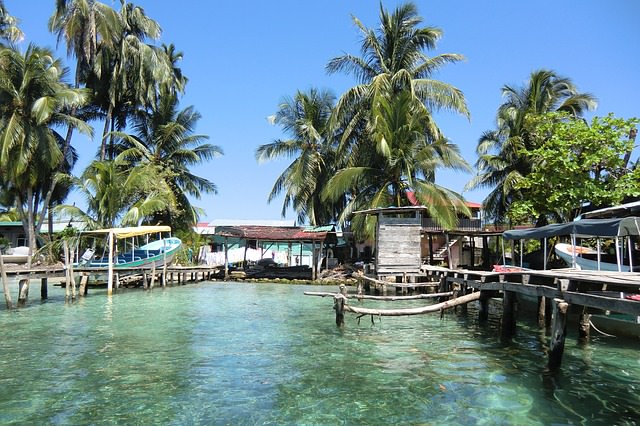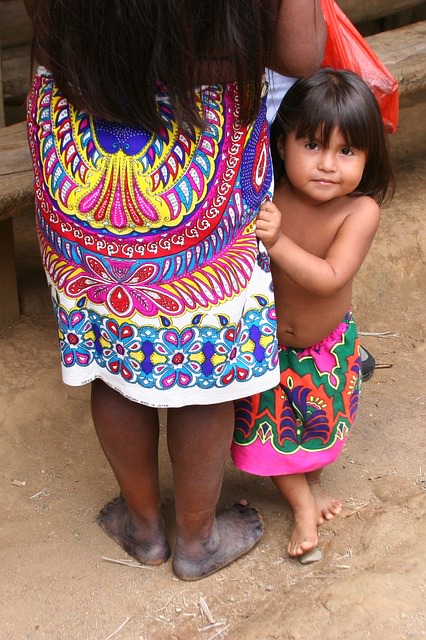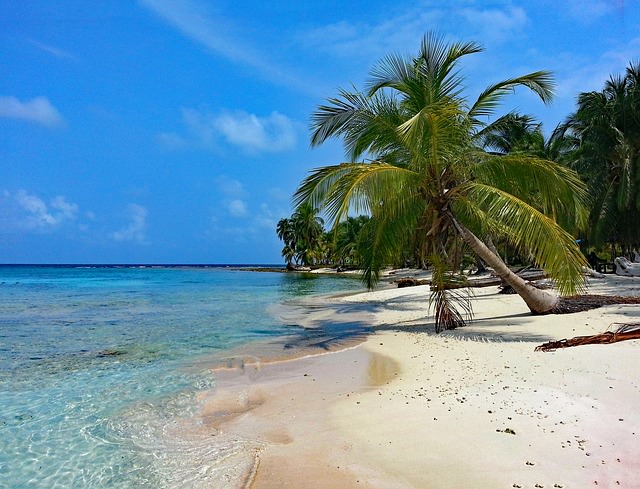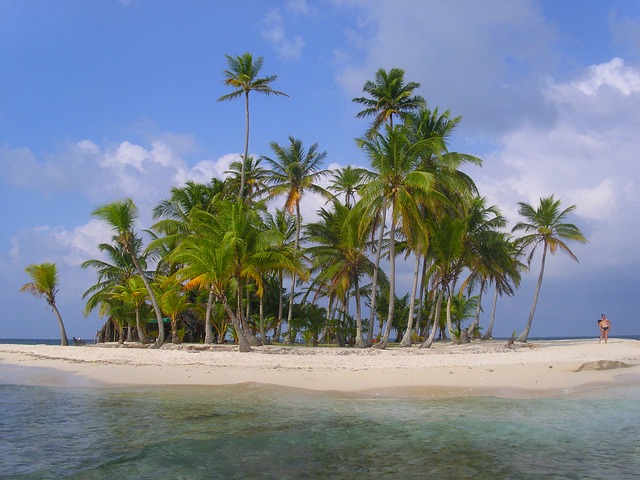Backpacking in Panama
Panama is not necessarily the backpacker country par excellence. Why not, one wonders? Maybe it is too small or maybe not adventurous enough? The latter can already be. The presence of the Americans, who have declared the country or rather the Panama Canal to be their elixir of life as well as the oil, have ensured that Panama itself has a Yankee touch. Nevertheless, Panama has a lot to offer that is worth exploring. From the deepest primeval forests to pulsating metropolises to paradisiacal island worlds, you will discover everything on your Panama trip. Let’s take a closer look at the country and show a few of its peculiarities below.

Backpacking in Panama – Paradise
Experience Panama
The Central American country has 3 million inhabitants and one fifth of the area of Germany. That means a lot of space. 44 inhabitants per km2 is not much compared to Europe, but compared to most South American countries it is. Despite the relatively small area you will encounter a versatile culture when crossing the country. The real Panamanian only exists on paper.
The truth is that the population is made up of seven different ethnic groups, some of which still cultivate their ancient customs. Above all, however, the geographical diversity has it in itself. You have on one side the Caribbean with its warm tropical waters and on the other side the Pacific with its somewhat rougher climate. If you don’t want to go by car from one side to the other, you can also do that by boat. Where can you do that? The Panama Canal leads from the Caribbean Sea in the north to the Pacific Ocean in the south.

Backpacking in Panama – Family
Playas or beaches are in abundance. After all, 1,915 km of coastline are waiting to be discovered by you. In between, you can let off steam in various national parks such as the Parque Nacional Altos de Campana with its rich biodiversity or the Parque Natural Metropolitano. And all this with constant warm tropical temperatures. Panama City is one of the most interesting shopping metropolises together with Miami in the Caribbean region.
In the bubbling city you can really enjoy the shopping craze. You’ll find local handicrafts as well as designer clothes from the most renowned brands. Try the local delicacies, many of which are fish and seafood, or discover the many adventures that range from scuba diving, rafting and jungle trips to exciting sailing trips.
Culture in Panama
Although the majority of Panamanians follow the Catholic faith, Jews, Protestants, Buddhists and Muslims also live in the country. In addition there are the indigenous people, who in many places still cultivate their old customs. As multi-faceted as the religions in Panama are, so multi-layered are also the represented races in the country, which then inevitably leads to a multi-faceted culture. Around 60 percent of the locals are Mestizo or Creole. Most of them live in the west in the regions Coclé, Herrera and Veraguas. Then follow the blacks and mulattoes, which are distributed around the BocasdelToro region.
Many white people live in the provinces of Panamá, Los Santos, while indigenous people from the tribes of Guaymí and Cuna live inland. During a visit of the indigenous tribes you can take part in the dances or get to know the typical Panamanian costumes. As a souvenir it is worth taking the Mola with you. This is a handmade embroidery that embellishes the blouses of the Kuna Indians. And clear. A real Panama hat is a must.
Backpacker Route in Panama
During your backpacker tours you don’t have to be prepared for gigantic distances between the best highlights. Everything is close together for Latin and especially South American conditions. There are several days of bus or night drives, but then you have to drive from one extreme to the other.
But that doesn’t mean that despite the relatively small area there is nothing to see. On the contrary. In Panama, exciting destinations await you in abundance. Because the country is small, but there are numerous combinations of different routes.
Whatever the planning of the backpacker route is, it is always important how much time and budget you have available. Of course, what you want to see is also important. A mixture of culture, adventure and activities is available in every region. You can make a short tour of a few days through the country, where only the absolute highlights await you, or you can take more time and discover the country intensively.
Panama Route 1: The classic (15-20 days)
- 2-3 Days Panama City – Shopping and Old Town Visit Miraflores
- 1-2 days Panama Canal and Museum visit
- 1 day to drive the railway line between Pacific and Atlantic Ocean.
- Visit 2-3 days Parque Soberania, Parque Chagres and Parque Metropolitano. The national parks covered with primeval
- forests are located just outside the gates of Panama City.
- 5-6 days relax and Iceland Hopping in BocasdelToro
Route 2: All or Nothing (32-42 days)
- 2-3 Days Panama City – Shopping and Old Town Visit Miraflores
- 1-2 days Panama Canal and Museum visit
- 1 day to drive the railway line between Pacific and Atlantic Ocean.
- Visit 2-3 days Parque Soberania, Parque Chagres and Parque Metropolitano. The national parks covered with primeval forests are located just outside the gates of Panama City.
- 5-6 days relax and Iceland Hopping in BocasdelToro
- 1-2 days rafting in Chiriqui, in Boquete on the Rio Chiriqui Viejo.
- 2 days Quetzal Trail in the National Park Boquete.
- 1 day to taste delicious coffee on a coffee plantation in Boquete.
- 1 day extension work on the Panama Canal in Colon.
- 1 day boat trips in the Gulf of Chiriqui.
- 3 days kayaking, rock climbing, horse riding or thermal springs in Chiriqui and Boquete.
- 3 days to explore San Blas island world.
- 1 day Panama Biomuseum.
- 1 day Isla Taboga – visit island, one boat hour from Panama City.
- 1 day El Caño open air museum near Natá
- 10 days exploring national parks in Panama. Alone almost 1000 bird species are known in the parks. In addition, indigenous tribes can be visited.
Panama Culture
The best national parks are:
- Parque Internacionalla Amistad
- Parque Nacional Volcán Barú
- Parque Nacional Cerro Hoya
- Parque Nacional Sarigua
- Parque Nacional General Omar Torrijos Herrera
Travel times in Panama
Panama can be visited all year round. There is a typical tropical climate with only two seasons. The dry season stretches from January to April and the rest is from May to about mid-December is the rainy season. The temperatures vary in summer – the dry season – from 28 to 36 degrees. In the rainy season the temperatures fall despite the rising rainfall only insignificantly. Even at night it is humid-hot and humid. With almost 100 percent humidity it is not possible to sleep very well, especially shortly after arrival.
Backpacker Budget in Panama
Due to the good transport infrastructure in Panama, travelling is easy or facil. Due to the small size of the country, it is not worth taking one of the two regional airlines Aeroperlas and Air Panama. Rather a nice train ride would be to be recommended. A route between Panama City and Colón is still in operation.
For about 20 Euro you could go for the single trip. A flight would come to you about the double. Better then still take the train, because it goes along the Panama canal at times and the jungle is crossed. Bus travel is the other option. The interdepartmental bus lines cross the country in all directions. The thing is that they are cheap compared to Europe.
It looks similar with the city buses. These are called “Diablos Rojos” or “Red Devils” and are always full of props. Good hunting grounds for thieves. Now you should know that the local currency in Panama is at least theoretically the Balboa. However, this only exists in coin form and is 1:1 pegged to the US dollar. And exactly with this US dollar is also paid. Otherwise it is said that the prices are somewhat higher than in the USA. But not all of them. Public transport is also much cheaper than in Western European countries. Shopping on the other hand is not as cheap as you might think. A litre of milk costs at least one Euro.
Prices in Panama
- Accommodation in Dorm between 9 and 11 Euro
- Bus or train ticket short distance 0,2 Euro
- Café in a pub 1 Euro
- Daily menu middle class 3 Euro
- Dinner Middle class restaurant 12 Euro
- Cola from the vending machine 0,7 Euro
- Newspaper 0,3 Euro
- Taxi from the airport to the city 25 Euro
Travel expenses and overnight stay in Bocas del Toro
An absolute must during a Panamatrip is the island world of Bocas del Toro. To get to the main island Isla Colón, you drive to Almirante, from where you can translate for a handful of dollars with simple boats. If you come from Costa Rica, take the boat in Changuinola. Costs also only insignificantly more. There are several hostels. Put down 10 dollars and you get a bed in a dorm. The most famous hostels are Aqua Lounge or Mondo Taitu. Every night you can go to the beach pubs there.
Backpacker Accommodation in Panama
In Panama, the types of shelter are as diverse as the biodiversity. Whatever type of accommodation there is, Panama has it. However, this also means that the prices for an overnight stay can vary considerably. In a 5 star hotel in Panama City you can already plan a few hundred euros for a night in a suite. The same applies to the exclusive logdes in the island paradises of San Blas or Bocas del Toro.
But of course you will also find much cheaper accommodations in the whole country. If you don’t want to stay in an exclusive golf hotel, then look around for a good hostel in Panama. But also here the prices for a bed in the different regions of the country are far apart. At Hostelworld you will find a list of average prices per region.
- Panama City 13 – 15 Euro
- Bocas del Toro 13 Euro
- Boquete 9 Euro
- David City 11 Euro
- Las Tablas 14 Euro
- Chame 16 Euro
- Puerto Lindo 9 Euro
- Penonome 15 Euro
It doesn’t seem very inexpensive. Of course it depends on the season again. Special rates await you outside of the main travel periods. Other types of accommodation that might be interesting for you are Cabañas. These are cabins that are equipped with all necessities depending on the standard. Also the relatively inexpensive and family-oriented Bed & Breakfast is offered.
You can also settle down in a usually quite expensive resort or spend a few days in a Posada or an apartment hotel. Even whole houses (casas) can be rented for a short or longer period of time. Especially if you travel in groups, this can be worth it. Apartments, bungalows or a night in a motel or a hostería are other alternatives.
Camping in Panama
Camping in Panama is not completely unknown, but there are not too many campsites. But they do exist. There are always some in the national parks. The standard is mediocre. There are also some good ones among them. The places are not expensive. Calculates once so between 5 and 10 euro per head. Free camping is such a thing. Where no plaintiff, there no judge, says an old proverb.
Backpacker Trips, Tips & Highlights in Panama
You must have seen the archipelago Bocas del Toro, in the extreme northwest of Panama. There is also a national park to be found. The best beaches are Boca del Drago on Isla Colón or Playa de Cayo Zapatillas and Rana Roja beach on Isla Bastimentos. An excursion to the numerous dolphins that cavort in the Bahía de los Delfines is a must. Trekkers who want to hit their way through the bushes can do so on Isla Bastimentos.
A tip for the really tough guys among you. The border area to Colombia is still not satisfied. Smugglers and drug dealers from Colombia, as well as other dubious figures still make the region unsafe. You know the old saying: Whoever puts himself in danger dies in it.
Backpacker Highlights in Panama
A must for adventurers are the many national parks in Panama. There are 14 national parks in Panama. You should know that there are also the most spectacular highlights of the country waiting for you. After all, 900 bird species, 1500 tree species and much more have settled in Panama.
Parque Internacional La Amistad
The park is jointly managed by Panamá and Costa Rica. You will find a park with the oldest preserved tropical primeval forests in Central America.
Parque Nacional Volcán Barú
Nature especially around the Barú volcano. At the same time with 3,475 m the highest point of the country.
Parque Nacional Marino Isla Bastimentos
Only one hour by plane from Panama City you will find the Marine National Park IslaBastimentos. Sea turtles lay their eggs there at a certain time. Snorkel is a must.
Parque Nacional Isla Coiba
Another worth visiting marine park that stretches over 270,125 ha is ParqueNacionalIslaCoiba. You can visit small islands like Coiba, Jicarón, Canal de Afuera, Uvas, and others. A lot of water sports are offered.

Backpacking in Panama – isla diablo
Parque Nacional Sarigua
In the east of the peninsula Azuero, about 45 minutes from Chitré, the Parque Nacional Sarigua is waiting for your visit.
Parque Nacional Cerro Hoya
The Parque Nacional Cerro Hoya is located in the very south of the Peninsula de Azuero with a view to the Pacific Ocean. It is considered to be the least explored park in the country.
Parque Nacional Altos de Campana
In the Natinola Park Altos de Campana you will discover a rich biodiversity.
Parque Natural Metropolitano
Even in the city of Panama there is a national park. You can discover more than 200 bird species, reptiles and mammals on trails.
Parque Naciona lSoberanía
You can see the mighty bird of prey Harpia in the Parque Nacional Soberanía. A real rarity. Really fat Brummer.
Parque Nacional Camino Las Cruces
The Camino Las Cruces National Park is one of the youngest in the country.
Parque Nacional Portobelo
Thick tropical forests await you only 2 hours away from Panama City in the Parque Nacional Portobelo. There are also numerous colonial fortifications.
Parque Nacional Darién
Probably the largest and most beautiful park in the world, the Emberá, Wounaan and Kuna tribes still live here. The Eldorado for birdwatchers is home to more than 300 bird species.
Backpacker Insider Tips in Panama
Cross once the Causeway or also the so-called Calzada de Amador. The route connects the islands Naos, Flamenco and Perico via the sea. The route starts at the southern section of the Panana Canal. You enjoy a great view over the city and the canal. On the Pacific side of Panama you can go on a whale watching tour. Especially around the islands de Coiba, Taboga and around the archipelago de Las Perlas the whalers feel comfortable. Also in the gulf of Chiriquí, San Miguel, IslaIguana and in the bay of Panama they cavort.
With a cable car you can fly over the jungle in the Gamboa Rainforest Resort. You’ll land on the Cerro Pelado and from there it’s a short walk to the viewpoint over the jungle. If you’re looking for the nightlife in Panama, you’ll find it mainly in Calle Uruguay in Panama City as well as in the old town of Casco Antiguo and on the already described way over the islands Naos, Flamenco and Perico.
Food & Drinks in Panama
Panamanian cuisine is similar to that of Colombia. On the basis of beef, fresh vegetables and many tropical fruits the tastiest meals are prepared. For little money you can fill your stomach in the simple pubs. Street stalls are even cheaper. Who wants to enjoy the typical Panama kitchen on a good level, goes in Panama City to the venerable Las Tinajas. Original national folklore is also included. A similar establishment is the El Trapiche in Vía Argentina, next to the casino.
Food in Panama
The Mi Ranchito on the Isla Naos de la Calzada de Amador with a breathtaking view of the Ciudad de Panamá is also a real insider tip. Low budget travelers and backpackers go straight to the Mercado del Marisco, the seafood market and feast on the delicacies at small stalls. The roots of the Panamanian cuisine are manifold and are based on indigenous descent that has developed over time with black African elements and the European cuisine brought by the immigrants. Especially on the coasts a lot of fish and seafood is eaten.
The offer is rich and different from coast to coast. Also rice is eaten a lot. Simple rice dishes that you can find cheap everywhere are: Arrozconpollo (rice with chicken) and Arrozconcoco (rice with coconut). You can also try different kinds of soups like Sopa de carne (meat soup) or Sopa de cabeza de pescado (fish head soup). As in many other countries of South and Central America, tortillas are also very popular in Panama.
Suckling pig is eaten just as gladly times as the Chorizzo sausages. For the hunger between times it is recommended to fall back on the Empanadas. The Empanadas are crescent-shaped or round dumplings with different fillings. They are available both baked and deep-fried. Popular desserts in Panama are among many others Queque, Mazamorra and Suspiros. Suspiros literally means sigh. The delicious Baizers will probably elicit a pleasurable sigh from one or the other.
Drinks in Panama
Beer is also available in Panama. The imported beers are usually better than the local brews, but also more expensive. Rum is drunk pure or as a mix. Those who don’t like alcohol can try one of the many fruit juices including Chicha de Saril or Chicha de Nance. It is also worth trying a palm wine.

Panama Backpacker
Backpacker Visa and Vaccination in Panama
According to the Federal Foreign Office, the following entry regulations apply in Panama. Entry requirements for German citizens. Entry is possible for German citizens with the following documents:
- Passport: Yes
- Provisional passport: Yes
- Identity card: No
- Temporary identity card: No
- Children’s passport: Yes, with photo
Comments:
The travel documents must still be valid for at least 3 months upon entry. Children’s entries in a parent’s passport are no longer valid as of 26.06.2012. Each child needs his or her own identity document.
Visa
A visa is not required for stays of up to 180 days. Either a return flight ticket to Germany or a valid onward travel ticket (land / air) and a valid residence permit for the country of onward travel (a tourist visa alone is not sufficient) must be presented.
Vaccinations & medical information
A valid vaccination against yellow fever is required for all travellers older than 12 months of age entering from a yellow feverendemic area. For direct entry from Germany, no proof of yellow fever vaccination is required, but vaccination is strongly recommended to all travellers.
Malaria
There is a low risk in the provinces of the Atlantic coast (above all Bocas del Toro in the northwest) and in the border areas to Costa Rica and Colombia (Colon, Chiriquí, Darién, Ngobe Bugle, Panama, Kuna Yala (SanBlas), San Blas Islands and Veraguas). The other parts of the country, including urban areas, are considered malaria-free.
Dengue: Dengue fever is transmitted nationwide by diurnal mosquitoes. Leishmaniasis occurs nationwide. Throughout the year, leptospirosis can be transmitted sporadically by water contaminated with rodent excrements.
